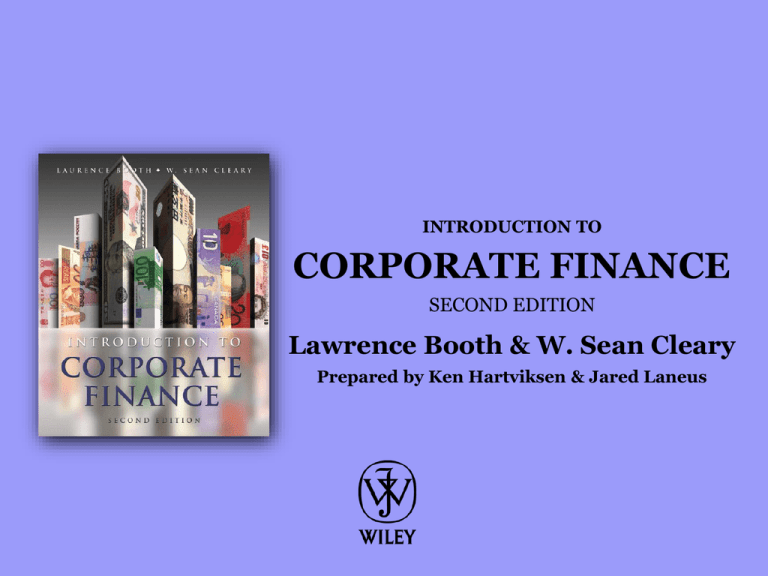
INTRODUCTION TO
CORPORATE FINANCE
SECOND EDITION
Lawrence Booth & W. Sean Cleary
Prepared by Ken Hartviksen & Jared Laneus
Chapter 1
An Introduction to Corporate Finance
1.1 Real versus Financial Assets
1.2 The Financial System
1.3 Financial Instruments and Markets
1.4 The Global Financial Community
Booth/Cleary Introduction to Corporate Finance, Second Edition
2
Learning Objectives
1.1 Define finance and explain what is involved in the study of
finance.
1.2 List the major financial and real assets held by Canadians
and the major sectors in the financial system.
1.3 Explain how is money transferred from lenders to
borrowers and the role played by market and financial
intermediaries.
1.4 Identify the basic types of financial instruments that are
available and explain and how they are traded.
1.5 Explain the importance of the global financial system and
how Canada is impacted by events in the U.S. mortgage
market.
Booth/Cleary Introduction to Corporate Finance, Second Edition
3
What Is Finance?
• Finance is the study of how and under what terms
savings (money) are allocated between lenders
and borrowers.
• Finance is distinct from economics in that it
addresses not only how resources are allocated,
but also under what terms and through what
channels resources are allocated.
• Financial contracts or securities occur whenever
funds are transferred from issuer to buyer.
Booth/Cleary Introduction to Corporate Finance, Second Edition
4
The Study of Finance
• The study of finance requires a basic
understanding of:
• securities
• corporate Law
• financial institutions and markets
Booth/Cleary Introduction to Corporate Finance, Second Edition
5
Real versus Financial Assets
• Real assets are tangible items owned by persons and
businesses; e.g.:
•
•
•
•
Residential structures and property
Major appliances and automobiles (consumer durables)
Office towers, factories, and mines
Machinery and equipment
• Financial assets are what one individual has lent to
another, e.g.:
• Consumer credit
• Loans
• Mortgages
Booth/Cleary Introduction to Corporate Finance, Second Edition
6
The Household Balance Sheet
• Households hold both real and financial assets
• Households also acquire some of those assets
through debt
• A household with no financial assets often faces
financial problems because real assets cannot be
easily used to pay off or service debt (i.e., make loan
payments)
• Real assets are not as liquid as most financial assets.
Booth/Cleary Introduction to Corporate Finance, Second Edition
7
Assets and Liabilities of Households
Booth/Cleary Introduction to Corporate Finance, Second Edition
8
The Financial System: Overview
• The household is the primary provider of funds to
businesses and government.
• Households must accumulate financial resources
throughout their careers to have enough savings
(pension) to live during their retirement.
Booth/Cleary Introduction to Corporate Finance, Second Edition
9
The Financial System: Overview
• Financial intermediaries transform the nature of the
securities they issue and invest in (e.g., banks, trust
companies, credit unions, insurance firms, mutual
funds)
• Market intermediaries, such as investment dealers
and brokers (investment advisors), simply help to
make markets work by adding liquidity.
Booth/Cleary Introduction to Corporate Finance, Second Edition
10
The Financial System: Channels of Intermediation
Funds can be channeled from savers to borrowers in three ways:
1. Direct transfer from saver to borrower in a non-market transaction.
2. Direct intermediation through a market intermediary such as a
broker in a market-based transaction.
3. Indirect claims through a financial intermediary where the financial
intermediary, such as a bank, offers deposit-taking services and
ultimately lends the deposited funds out as mortgages or loans.
11
Booth/Cleary Introduction to Corporate Finance, Second Edition
The Financial System: Financial Intermediaries
Canadian Chartered Banks
• Deposits from numerous depositors from across
Canada are ‘pooled’ into banks
• Pooled funds are lent to households and
businesses in the form of mortgages and loans
Booth/Cleary Introduction to Corporate Finance, Second Edition
12
The Financial System: Financial Intermediaries
Canadian Chartered Banks
(continued)
• The bank transforms the original nature of the
savers’ (depositors’) money:
• Individual depositors save in small amounts and want
to face little or no risk, but expect to be able to
withdraw their deposit at any time.
• Loans and mortgages are usually large in amount,
borrowed for long periods of time and for risky
purposes, and may not always be repaid in full.
• Banks can perform this transformation function
because they become experts at risk assessment,
financial contracting (pricing the risk), and
monitoring the activities of borrowers.
Booth/Cleary Introduction to Corporate Finance, Second Edition
13
The Financial System: Financial Intermediaries
Canadian Chartered Banks
Booth/Cleary Introduction to Corporate Finance, Second Edition
14
The Financial System: Financial Intermediaries
Insurance Companies
• Insurers sell policies and collect premiums from customers
based on the pricing of those policies given the probability of
a claim and the size of the policy and administrative fees.
• Premiums are invested so that the accumulated value in the
future will grow to meet the anticipated claims of the
policyholders.
• Risks that would be unsupportable by an individual, such as
the death of wage earners or the destruction of a business’s
assets by fire, are therefore shared among a large number of
policyholders through the insurance company.
• Insurance allows households, business and government to
engage in risky activities without having to bear the entire risk
of loss themselves.
Booth/Cleary Introduction to Corporate Finance, Second Edition
15
The Financial System: Financial Intermediaries
Insurance Companies
Booth/Cleary Introduction to Corporate Finance, Second Edition
16
The Financial System: Financial Intermediaries
Pension Plan Assets
• Individuals and employees make payments over their
entire working lives to pension plans, which invest those
funds to grow over time.
• The accumulated value of the pension can be used to fund
retirement.
• Pension plans accumulate large sums of money; their
managers invest those funds with long-term investment
time horizons in diversified investment portfolios.
• These investments are a major source of capital, fuelling
investment in research and development, capital
equipment, and resource exploration, which ultimately
contributes to the growth of the economy.
Booth/Cleary Introduction to Corporate Finance, Second Edition
17
The Financial System: Financial Intermediaries
Pension Plan Assets
Booth/Cleary Introduction to Corporate Finance, Second Edition
18
The Financial System: Financial Intermediaries
Canadian Mutual Fund Assets
• Mutual funds give small investors access to diversified,
professionally-managed portfolios of securities.
• Small investors often do not have the funds necessary to
invest directly into market-traded financial instruments (e.g.,
stocks and bonds).
• This process is called denomination intermediation because
the mutual fund divides investments denominated in larger
amount of fund into smaller, more affordable amounts. (e.g.,
a $1 million Treasury bill could be purchased in $10 units in a
money-market fund.)
• Canadian indirect investment in the markets through
managed products such as mutual funds and segregated
funds has grown exponentially in recent years.
Booth/Cleary Introduction to Corporate Finance, Second Edition
19
The Financial System: Financial Intermediaries
Canadian Mutual Fund Assets
Booth/Cleary Introduction to Corporate Finance, Second Edition
20
The Financial System: The Major Borrowers
• Public Debt:
• Government of Canada (the federal
government)
• Provincial and territorial Governments
• Municipalities
• Crown corporations
• Private Debt:
• Households
• Non-financial corporations
Booth/Cleary Introduction to Corporate Finance, Second Edition
21
The Financial System: The Major Borrowers
Booth/Cleary Introduction to Corporate Finance, Second Edition
22
Financial Instruments: Overview
There are two major categories of financial securities:
1. Debt instruments: Examples: commercial paper,
bankers’ acceptances, Treasury bills (T-bills),
mortgage loans, bonds, debentures
2. Equity instruments: Examples: common share,
preferred share
Booth/Cleary Introduction to Corporate Finance, Second Edition
23
Financial Instruments:
Characteristics of Non-Marketable Assets
Non-Marketable Assets:
• Cannot be traded between or among investors
• May be redeemable (a reverse transaction between
the borrower and the lender): Examples: savings
accounts, term deposits, guaranteed investment
certificates (GICs), Canada Savings Bonds
Booth/Cleary Introduction to Corporate Finance, Second Edition
24
Financial Instruments:
Characteristics of Marketable Assets
Marketable Assets:
• Can be traded between or among investors after
their original issue in public markets and before
they mature or expire
• The market value will change over time due to
changes in the general economic environment (for
example, interest rate increases or decreases)
and/or changes in the financial condition or
prospects of the issuer of the security.
Booth/Cleary Introduction to Corporate Finance, Second Edition
25
Financial Instruments:
Characteristics of Marketable Assets
Marketable securities can be categorized according
to their time to maturity:
• Money market securities are short-term debt
securities that are pure discount notes and usually
have maturities less than one year.
• Examples: Bankers’ acceptances, commercial paper,
Treasury bills.
• Capital market securities are long-term debt or equity
securities with maturities greater than one year.
• Examples: bonds, debentures, common and preferred
shares
Booth/Cleary Introduction to Corporate Finance, Second Edition
26
Financial Markets: Overview
1. Primary Markets: Markets that involve the issue of
new securities by a company in exchange for cash
from investors.
2. Secondary Markets: Markets that involve buyers
and sellers of existing securities. Funds flow from
the buyer to the seller of the securities, and the
buyer becomes the new owner of the security. No
new capital is formed; this is only the exchange of
already existing securities representing already
formed capital.
Booth/Cleary Introduction to Corporate Finance, Second Edition
27
Financial Markets:
Types of Secondary Markets
• Exchange or auction markets involve a bidding
process that takes place in a specific location.
• Examples: Toronto Stock Exchange (TSX), New York
Stock Exchange (NYSE)
• Dealer or over-the-counter (OTC) markets do not
have a physical location and consist of a network of
dealers who trade directly with each other.
• Example: bond market
Booth/Cleary Introduction to Corporate Finance, Second Edition
28
Financial Markets: Market Capitalization
• Market capitalization is the total market value of a
company.
• Calculated by multiplying the number of shares
outstanding by the market price of each share.
Market Cap = # of Shares × Share Price
Booth/Cleary Introduction to Corporate Finance, Second Edition
29
Financial Markets: Other Markets
• Third Market
• The trading of securities that are listed on organized
exchanges in the over-the-counter (OTC) market
• Fourth Market
• The trading of securities directly between investors
(usually between two large institutions) without the
involvement of brokers or dealers
• Operates through the use of privately owned
automated systems such as Instinet
Booth/Cleary Introduction to Corporate Finance, Second Edition
30
Financial Markets:
The Global Financial Community
• Represents an important source of funds for
borrowers as seen in Table 1-7
• Provides investors with important alternatives as
they seek to build wealth through diversified
portfolios
• Money markets and bond markets are global
• Domestic equity markets are increasingly linked
because of globalization and consolidation
• The correlation between markets is high, especially
during a systemic downturn as seen in Table 1-8.
Booth/Cleary Introduction to Corporate Finance, Second Edition
31
Booth/Cleary
Introduction to Corporate
Finance, Second Edition
32
The Financial System:
The Global Financial Community
Booth/Cleary Introduction to Corporate Finance, Second Edition
33
Copyright
Copyright © 2010 John Wiley & Sons Canada, Ltd. All rights
reserved. Reproduction or translation of this work beyond that
permitted by Access Copyright (the Canadian copyright licensing
agency) is unlawful. Requests for further information should be
addressed to the Permissions Department, John Wiley & Sons
Canada, Ltd. The purchaser may make back-up copies for his or her
own use only and not for distribution or resale. The author and the
publisher assume no responsibility for errors, omissions, or
damages caused by the use of these files or programs or from the
use of the information contained herein.
Booth/Cleary Introduction to Corporate Finance, Second Edition
34






